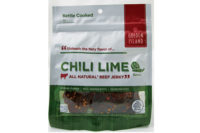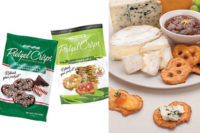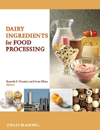“The main driving factor for new gums and starches in baked goods relates to market trends, pricing and availability,” says Janae Kuc, senior research and development scientist, Gum Technology Corp., Tucson. “Guar gum has seen a spike in use in the oil industry for fracking, which in turn, affects the food industry. Xanthan gum is now a focus, due to the anti-dumping litigation. Based on the findings in the litigation, the prices of xanthan gum will be increasing due to increased tariffs on importing xanthan gum.
“The guar gum situation, as well as the current xanthan situation, has caused [manufacturers] to begin looking at alternative options. Xanthan gum and guar gum are some of the most commonly used gums in the baking industry. Now, interest in other gums or gum combinations such as tara gum, fenugreek gum, cellulose gum (CMC) and konjac is becoming more prevalent.”
Kuc says Gum Technology is continuously developing new products to address these issues. “With the push for xanthan gum replacement in baked goods, we recently developed a few different blends that will help provide similar or improved functionality. Some of our blends contain citrus fiber, which is a great moisture binder and can help extend product shelf life. For baked goods and tortilla applications, Hydro-Fi TC-1123, which is a blend of tara gum and citrus fiber, is a good replacement option. Other products such as our Coyote Brand Stabilizer CT-1201, which is a blend of CMC and tara gum helps to mimic xanthan’s functionality in baked goods.”
Harold Nicoll, marketing manager for TIC Gums, White Marsh, Md., also says the limited supply of guar gum has driven the developments of guar gum replacements and extenders using gum blends. “Guar gum offers many advantages to food product designers who need texture, viscosity and stability in a wide variety of creations,” he explains. “However, ongoing demand from the oil and gas industry has turned guar into something of a wild card.”
In response, TIC Gums developed several gum systems to help the food industry manage the limited guar gum supply. These include Ticaloid Lite Powder Guar Gum Extender, which improves the texture and mouthfeel of cakes, breads and similar bakery products, as well as increases their moisture retention; Ticaloid 451 T, which has been tested in a gluten-free baked good as a way to improve texture and increase volume; and Add-Here Systems, which provides texture and stability solutions for the snack and baking industry. Add-Here 3200 has proved effective in binding syrups with reduced sugar for granola and energy bars, while Add-Here CSA reduces particulate loss in production and the final packaging by creating a stronger film. Inclusions stay on products without additional coatings such as an egg wash or high fructose corn syrup.
The use of starches in the baking industry, meanwhile, has increased over the past five years, due to “certain cost, supply and consistency problems with gums,” says Lisa Tuohy, senior food scientist, applications, for London-based Tate & Lyle. “Starches provide an advantage with their high water-holding capabilities, lower cost and clean-label operations.”
Mel Festejo, COO of American Key Food Products, a Closter, N.J.-based distributor of native potato, modified food, tapioca, corn, sago and rice starches, says growing demand for clean labels is also spurring the development and use of new starches. “Starch manufacturers have acknowledged the growing need for clean-label ingredients and put out starches with enhanced functionalities without chemical modifications,” he says. “Where chemically-modified starches were the go-to starch ingredients for more challenging applications, a new breed of physically-
modified starches is being developed and rolled into the market.
Success with starch
“Starches from nontraditional raw materials, whether produced in pure starch form or as starch-rich flours, are finding their way into the baking and snack industries. Thus, starches and flours from such varied sources as exotic grains, cassava roots, waxy rice, sago, yellow peas and arrowroot are getting a serious second look.”
Minneapolis-based Cargill, which produces a variety of ingredients, including starches and hydrocolloids, receives requests from customers to help reformulate gums and starches for many reasons, says texturizing solutions technical manager Wendy Erickson. She cites bakers’ and snack producers’ desire to incorporate fiber into their products as one example. “We have a product that helps meet some of the requirements for enhancing with fiber,” she explains. “Our ActiStar product does that. It’s a modified food starch product that has a high percentage of dietary fiber and is easy to incorporate into baked products.”
Cargill is also getting more involved in cost optimization, as companies try to manage ingredient costs during tough economic times, says Erickson. “We’ve been helping customers reformulate from an ingredient, formulation and processing perspective,” she says. “When we look at ingredients and bakery and snack products, one of the more expensive ingredients is proteins, which can also be potentially volatile and have allergen applications. We have a couple of products in the starch area—one is EmTex [modified starch] and one is EmCap [instant modified starches]—that could help replace some of the functionality of eggs in baked products, for instance.”
Recent gum and starch developments are also enabling bakers and snack producers to enjoy the best of both of these ingredients. “In the past, bakery and snack segments used starches and gums independently,” explains Dr. Ibrahim Abbas, senior research and development manager, Penford Food Ingredients, Centennial, Colo. “But over the past few years, suppliers have been creating synergistic starch-gum blends to improve product functionality, health and cost.
“One bakery segment that this applies to is the gluten-free market. Synergistic starch-gum blends, such as PenTech GF, have been able to create high-quality, gluten-free baked goods. Formulating gluten-free products is a constant challenge since the bakery mixes do not comprise traditional wheat flour.”
Bryan Scherer, director of research and development at Penford, also cites increased demand for gluten-free offerings, as well as allergen replacements (eggs and dairy), fiber enhancement, reduced sugar and fat and cost improvement as market drivers. He points out that the company has created several products to address these issues, including PenTech GF technology, customized, gluten-free blends for baked products such as breads, muffins, tortillas and snacks; PenTech NG liquid or dry whole egg and egg yolk replacer for baked products; and PenNovo 00, which can replace dry egg whites in specific gluten-free products, such as bagels.
“When replacing rice flour in gluten-free products, the product has shown to improve volume by 225%,” Scherer says of PenNovo 00. “This same product can also replace egg wash, while still maintaining sheen and provide superior adhesion for topicals such as spices and seeds.”
For fiber enrichment, Penford offers PenFibe RS, a nonallergenic, potato-based resistant starch that requires minimal reformulation due to its minimal water holding capacity, making it a good fiber choice for baked products, according to Scherer.
Consumer drivers
Demand for and development of new gums and starches is driven by consumer trends, as well as industry issues and manufacturers’ needs.
“Over the past five years, the average consumer has become more aware of the ingredient and nutritional information for food products,” Nicoll explains. “This awareness extends beyond the grocery store, as many restaurants are now displaying calorie counts or coming up with healthy fare to be featured on their menus. The overall increased focus on health trends is driving food manufacturers to discover new ways to develop products without sacrificing taste. Gums and gum systems are now used to assist in texture and stability when sugar is reduced, wheat is removed or fiber is added. Food manufacturers that supply baking and snack products to restaurants and grocery stores now have more options that are beneficial and economical.”
Clean-label scrutiny
In addition to restaurant menus, consumers are also scrutinizing product labels, looking for genetically modified organisms (GMOs), unfamiliar ingredients, low sodium and sugar content, allergens and glutens. “The baking and snack industries have begun to address the requirements for nonallergenic and gluten-free ingredients, segments that have been steadily growing over the past few years,” says Festejo. “The starch industry has responded and developed not only clean-label starches, but clean-label application formulas to meet the functionality requirements in the bakery and snack food world.”
American Key Food Products, for instance, offers a portfolio of clean-label, nonGMO, nonallergenic and gluten-free products aimed at a number of specialty segments. At the core of this portfolio are potato and tapioca clean-label starches from the Emsland Group. Emsland’s Empure line includes potato- and pea-based, cook-up and instant starches that exhibit functionalities attributed to modified starches and are well-suited for clean-label products. Its Emfix emulsifying starches, meanwhile, can be used to replace egg ingredients in a variety of bakery applications.
Even though more Americans are reading product labels and are attempting to eat better, they’re still snacking. “Snacking is becoming a major part of consumers’ diets, so many more snack products are being introduced into the market,” says Michelle Kozora, product manager, texturants, at Tate & Lyle. “Consumers’ expectations for quality are higher than ever before, so gums and starches have an important role in helping resolve issues like cracker breakage, lack of dough binding and optimal texture when producing high-quality products. Consumers are also looking for healthy alternatives such as baked snacks instead of fried snacks.”
But some of today’s healthy-eating snack trends such as gluten-free, whole-grains and ancient grains, for instance, pose challenges for bakers and snack producers. “When working with ingredients like whole and ancient grains, it’s difficult to create cohesive, processable dough,” Kozora explains. “Starches like Tate & Lyle’s X-Pand-R Series contribute to excellent dough-binding characteristics that improve machinability and processing, as well as provide a nice texture bite in the finished product. For gluten-free applications, maintaining dough integrity, as well as providing a good texture in the finished product, is also a challenge. Tate & Lyle’s starches can help in these instances as well.”
The company recently added X-Pand-R 612F and X-Pand-R SC to the series. The former has a fine particle size that allows it into the snack matrix, like dough, says Kozora, as well as allows for further hydration of the starch, which can impact the final texture of the snack product. The latter provides a crispy, crunchy and more airy texture in the finished product.
Sugar replacement also requires the use of specialized starches, adds Scherer. “PenFibe RS potato-based resistant starch, in combination with non-nutritive sweeteners, can help reduce sugar content in some bakery and snack products,” he explains. “In food applications such as glazes and frostings, specialty starches can replace the sugar, while maintaining viscosity and sheen. However, since PenFibe RS does not contribute sweetness, formulators will need to use non-nutritive sweeteners to provide the same sweetness as a full-sugar product.”
Health issues such as celiac disease, diabetes, high blood pressure and food allergies are also prompting more consumers to seek out gluten-free, whole-grain-based, ancient-grain-based, low-sodium, low-fat and other better-for-you products. “Critics point out that these are [food] fads whose demand will ebb very quickly,” says Festejo. “Not so, as market statistics will bear out. Food consumers are getting more nutrition- and health-conscious in their choice of baked goods and snacks. Allergic conditions, especially celiac disease, are on a steady climb. The latter accounts for a market segment that will not go away and could grow significantly in the years to come. Thus, the food industry is prudently taking these developments seriously and constantly working with new ingredients, especially with flours and starches that will satisfy these specialized requirements without sacrificing too much on functionality.”
Like starches, gums help provide structure, moisture retention and texture in multiple baked good applications, including gluten-free. “In gluten-free products, gums help provide viscosity in the batter to mimic gluten bonds,” Kuc explains. “They also provide a more homogenous crumb structure and promote moisture retention, which helps keep the product from drying out.”
Gum Technology offers an assortment of products for gluten-free applications, says Kuc, including Coyote Brand GumPlete SXCT-GF-707, a blend of tapioca flour, rice flour, xanthan gum, citrus fiber and tara gum that can be used to make gluten-free brownies that are moist and chewy.
Cargill, meanwhile, is working on a modified food starch that will help address consumer demand low-fat baked goods. Scheduled to be released this spring, the new starch will help replace or reduce the saturated fats and overall fat profile in bakery products, Erickson says. “We’re primarily focused on cookies,” she explains. “We’ve been asked by many of our customers to help them achieve this [goal], now that they’ve basically eliminated trans-fats from their labels.”
Ingredient cost and availability, consumer eating trends, the move toward clean labels and a host of other factors are prompting bakers and snack producers to re-examine their product formulations and look for ingredient alternatives. Gum and starch suppliers are demonstrating that they’re more than ready to stick by their baking customers by developing new products that deliver.















